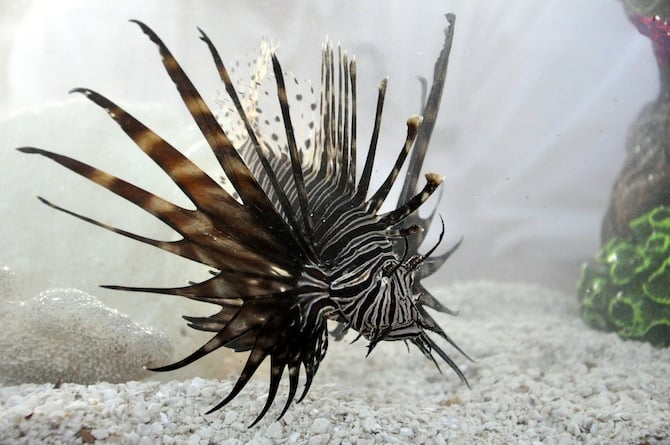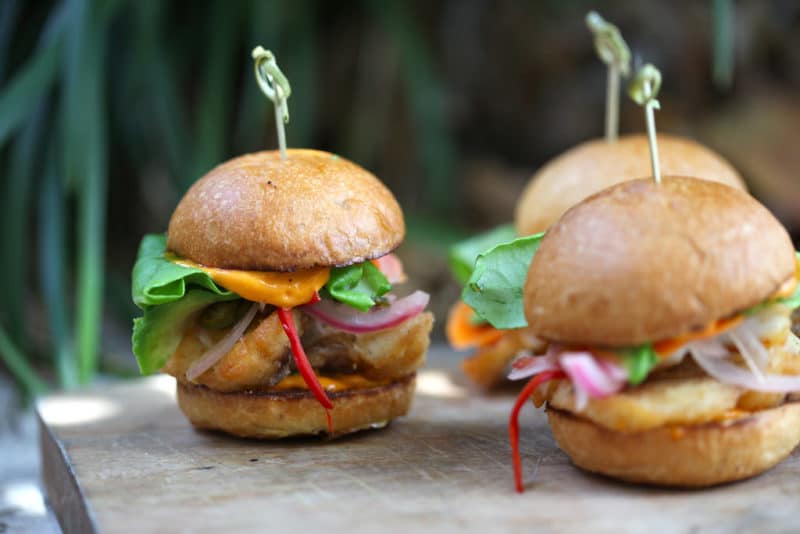Delicious Lionfish: Responsible Eating In The Cayman Islands

Lionfish are gnarly-looked creatures. Photo courtesy of Florida Fish & Wildlife.

Underwater beauty. Photo courtesy of LASZLO ILYES.
The Issue
You see, while abundant around the Cayman Islands, lionfish, a scary looking but delicious creature, are not native to local waters. They’re an invasive species that have somehow made their way to the Gulf of Mexico and Atlantic Ocean from the Indian and Pacific Oceans. According to the World Lionfish Hunters Association, it takes just one lionfish to kill up to 90% of a reef’s native species — which help keep reefs healthy — in its range in only five weeks. Along with having ravenous appetites, they produce 2 million offspring per year and have no natural predators, aside for the divers who cull them. “Because of lionfish, lobster could be threatened, conch could be threatened,” says Chef Tennant. “If the reef system dies then there’s no food or nutrients for anything of that nature, and a reef system will die if there’s no balance. Lionfish eat the fish that take care of the reef, constantly cleaning up and making sure it’s healthy. If those fish are gone, the reef can overgrow with bacteria and die.”What’s Being Done
All three Cayman Islands — Grand Cayman, Little Cayman and Cayman Brac — have culling programs where the fish are killed with spears, analyzed for research purposes and eaten. In fact, visitors who have dived locally can join a cull through Ocean Frontiers, even getting to eat their catch (without worry of over-fishing). Along with eating, there’s also a strong investment in the creation of the dish, as even those who aren’t chefs are often divers themselves who hunt lionfish. For Caymanians, diving is a big part of the culture. And as lionfish is an important issue, they’re likely to act on that. Lionfish aren’t like salmon or snapper that you can fish and filet yourself. These underwater creatures have 18 venomous spines that cause extreme pain when pricked, not to mention the need for antibiotics. Basically, don’t try this at home, kids. When Cayman Island chefs first started serving lionfish, locals were nervous, mainly because they didn’t understand the difference between a poisonous and venomous fish. Here’s the deal: While poisonous fish can make you sick when eaten, venomous fish, like lionfish, are only harmful if they inject you. Once cooked and plated, you’re good to go. Over time diners have not only come to realize they can eat lionfish, they want to eat it — to the point where restaurants can’t keep it in stock. “Lionfish are becoming more important from a culinary standpoint,” says Neil van Niekerk, manager of Little Cayman’s Southern Cross Club, which takes part in culling programs and has an onsite restaurant that serves the delicacy. “In fact, a small business has recently opened in Grand Cayman that is trying to service the demand and is importing Lionfish from Honduras as the demand is too high in Grand Cayman. Restaurants have even approached me in Little Cayman to service them, however, our own demands outweigh them.” Cayman Island locals genuinely care about the local reefs and their 365 dive sites, meaning they genuinely care about keeping lionfish populations under control. As many locals also work in tourism, diving and seafood industries, their livelihood depends on the control of the lionfish population.A Responsible Taste Of The Cayman Islands
Luckily, lionfish — which is high in health Omega 3 Fatty Acids — has a pleasant, non-fishy taste that mimics the flavors of the ingredients it is cooked with. At Michael’s Genuine, lionfish is served in a variety of ways: ceviche, tacos and fried lionfish sandwiches are the most popular, although it’s not uncommon to find it grilled, pan roasted or wood oven roasted. This allows the dish to lend itself to a variety of palates. Southern Cross Club also serves it in many ways, mainly as tacos. Unlike many culturally important dishes that have been passed down through generations, lionfish isn’t always something locals ate for Sunday dinner. It’s a food that embedded itself into the local culture due to necessity. Says Mr. van Niekerk “The outcome of this invasion is of dire consequence to the Caribbean region. Because the lionfish is a Generalist Predator — therefore indiscriminate in it’s approach to food — it has far reaching consequence to species across the food web. So much so, that the Lionfish is now higher on the Food Web than Sharks! This means that it interacts with more species than any other fish in the region. The only greater predator is Humans. We have to eat this fish. If we don’t, there will be no demand to control the number of fish impacting the reef.” Michaels’ Genuine Food & Beverage and Southern Cross Club are not the only Cayman Islands venues to serve lionfish. Some others include Guy Harvey’s Restaurant & Bar, Stingers Bar & Restaurant, Tukka Restaurant & Bar and The Hungry Iguana. Lionfish Sliders By Michael’s Genuine Food & Drink Makes 12 sliders Ingredients:- 1 tablespoons minced garlic
- 1/3 cup fresh lemon juice
- 1 scotch bonnet or habanero pepper, seeds removed
- ½ cup seasoning or shishito peppers, seeds removed
- 3 egg yolks
- 3 tablespoons kosher salt
- 1 cup extra-virgin olive oil
- 2 cups canola oil
- 1 ½ cups Pickled Vegetables (recipe follows)
- 12, 3-ounce lionfish filets, pin bones removed
- Kosher salt to taste
- Freshly-ground black pepper to taste
- 1 cup all purpose flour
- Vegetable oil for frying
- 12 potato rolls
- 1 cup picked cilantro leaves
- 1 cup scallions cut on the bias
- 1 cup baby arugula, washed
- 3 limes cut into wedges
- 3 ripe avocados, sliced
- Preheat a deep fat fryer to 350 degree Fahrenheit with vegetable oil.
- In a food processor, combine the garlic, peppers and lemons juice and puree until smooth, scraping down the sizes of the bowl every few moments.
- Once pureed, add the egg yolks and salt then run the food processor until the egg yolks have been whipped enough to be well incorporated with the pepper mix.
- While the food processor is running, combine the two oils and slowly incorporate them into the processor in the thin stream. You want to have an emulsification, so do not go too fast.
- Taste for seasoning and adjust if necessary.
- Season the lionfish filets with salt and peppers, then dredge in the flour.
- Fry until golden brown and cooked through.
- Place on to paper towels to soak any excess oil and season with salt.
- To assemble, slice the potato rolls in half and dry toast the cut side on a griddle.
- Liberally spread the aioli on both cut sides of the bread.
- In a small mixing bowl, combine the cilantro leaves, scallions and arugula and dress with a strong squeeze of fresh lime juice.
- Assemble each slider by placing the fried filets on the bottom half of the sauced rolls. Then thinly slice the avocado and place on the lionfish.
- Top with pickled vegetables and cilantro/arugula mix. Place the top half of the roll on top and secure with a sandwich pick.
- 2 cups unseasoned rice vinegar
- ½ cup sugar
- 2 bay leaves
- 1 teaspoon mustard seeds
- 1 thyme sprig
- Suggested vegetables: 1 small red onions sliced into 1/4-inch thick rounds and separated into individual rings 2 bell peppers, seeded and julienned 1 carrots, julienned
- Combine the vinegar, 1 cup water, sugar, bay leaves, and mustard seeds in a medium nonreactive pot.
- Slowly bring to a simmer over medium-low heat, stirring occasionally to dissolve the sugar.
- Put the vegetables in a heatproof nonreactive container and pour the hot liquid on top and toss to evenly coat; the vegetables should be completely submerged in the liquid.
- Cover and cool to room temperature.
- Chill before serving.
- The pickled red vegetables keep for months stored covered in the refrigerator. Be sure to keep them completely submerged in the liquid.




Hi, I’m Jessie on a journey!
I'm a conscious solo traveler on a mission to take you beyond the guidebook to inspire you to live your best life through travel. Come join me!
Want to live your best life through travel?
Subscribe for FREE access to my library of fun blogging worksheets and learn how to get paid to travel more!
Turn Your Travel Blog Into A Profitable Business
Subscribe to my email list to snag instant access to my library of workbooks, checklists, tutorials and other resources to help you earn more money -- and have more fun -- blogging. Oh, and it's totally FREE! :) // Privacy Policy.